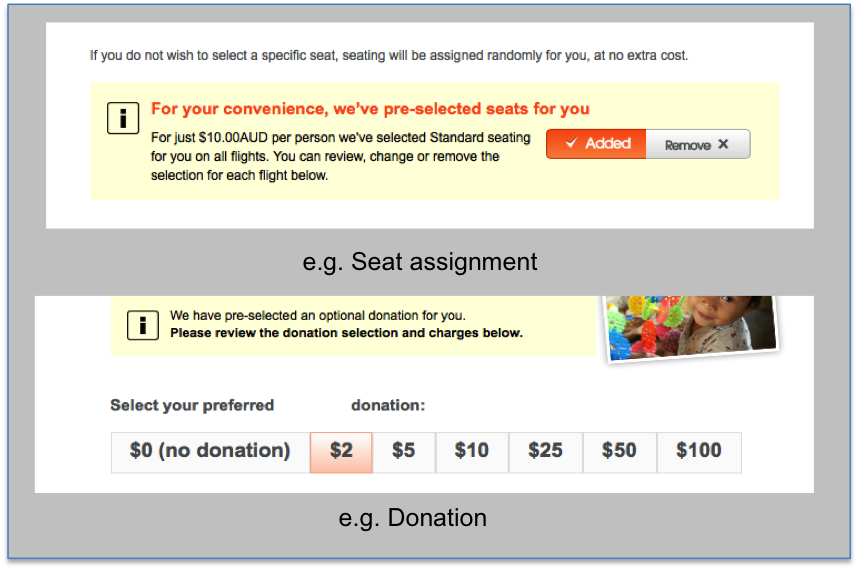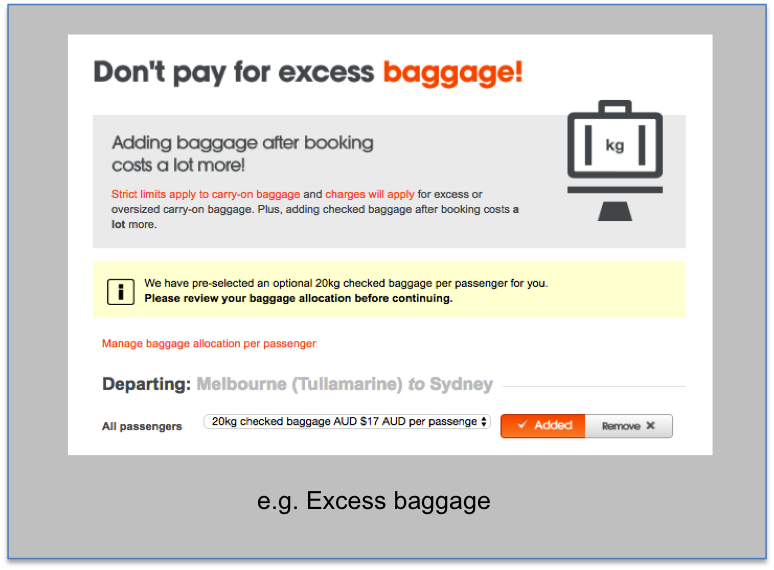There’s a cut-price airline, let’s call them “Cookiejar”, which uses a bag of behavioural techniques to influence its customers. Personally I think it is stretching the boundaries with its techniques but their practices are still worth picking apart to see what makes them behaviourally effective.
Here are four things they do to get customers to take action.
1. Defaults
Behavioural science has shown us that people have a default bias: they tend to stick with the option that has been pre-selected. Most famously, this has been proven to impact the rates of organ donation, with countries that opt people in and require them to opt out if they do not consent having significantly higher rates of donation than those that require people to opt in (like Australia).
Cookiejar has taken default bias and run with it, defaulting customers in for things like baggage, assigned seating and donations.
 2. Positive tension
2. Positive tension
Positive tension is the fear of missing out (FOMO) that stimulates people to take action, and is another important ingredient to break customer inertia.
Cookiejar creates positive tension in their customers by:
- creating a sense of scarcity (only nine seats left at a cheaper price); and
- listing more expensive payment options first, so the free options look like a better deal
Cookiejar also uses language to draw out people’s loss aversion – their fear of paying for excess baggage in this case.
 3. Design
3. Design
How you present options to customers can have a significant impact on their decision. Cookiejar is playing on the Center Stage Effect (a.k.a the “Goldilocks Principle”), where people are attracted to the middle option, by making it look more vibrant than the dull, gray Starter Package, and better value than the Max Bundle.
To top things off they use a “Most Popular” tag to cue customers about what others have done.
4. Environment
In their new terminal in Melbourne, Cookiejar has designed the space to keep passengers in the retail and dining precinct for as long as possible. How? They don’t release the gate number for your flight until close to boarding which means people have to hang around the departures notification board, conveniently located amongst shops and restaurants.
Elsewhere, you may have noticed that the walk to the baggage carousel is getting longer and longer in new airports.
This too is a deliberate behavioural strategy to keep people amused after some airports with short walks were bombarded with complaints of slow service. Why speed up the service when you can slow down the customer without them realising?
Lessons for your business
You don’t have to be an airline to use these behavioural techniques.
Here are four things you should consider implementing:
- Defaults: where possible (and ethical) use defaults to build momentum because it takes more effort to de-select than proceed;
- Positive tension: remind your customer what they have to lose is they don’t proceed with you;
- Design: be deliberate about how many options you present and how, and ensure that the middle option is your best margin because it will tend to be selected; and
- Physical environment: consider how to structure your environment to keep customers engaged
Bri Williams runs People Patterns, a consultancy specialising in the application of behavioural economics to everyday business issues.






COMMENTS
SmartCompany is committed to hosting lively discussions. Help us keep the conversation useful, interesting and welcoming. We aim to publish comments quickly in the interest of promoting robust conversation, but we’re a small team and we deploy filters to protect against legal risk. Occasionally your comment may be held up while it is being reviewed, but we’re working as fast as we can to keep the conversation rolling.
The SmartCompany comment section is members-only content. Please subscribe to leave a comment.
The SmartCompany comment section is members-only content. Please login to leave a comment.